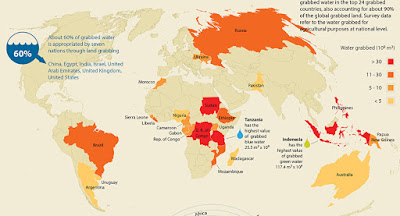Finale: An overview
Over the
past 12 weeks we have examined the critical role politics plays in developing
and managing shared water resources mainly on the Nile. The interaction between
governments, communities and private enterprise have been at the forefront of
this research- with the end goal of highlighting the importance of a
collaborative discourse between all stakeholders, establishing a common goal for
the long term sustainable future of water resources in East Africa.
“African water management is also, by definition, transboundary water management” (Kimenyi and Mbaku, 2015 p1)
“African water management is also, by definition, transboundary water management” (Kimenyi and Mbaku, 2015 p1)
 |
| The Nile River (Waddington, 2014) |
From a
development perspective, population change and demographic transitions have
been key in the discourse surrounding contemporary water management frameworks.
In 1990, the Nile basin population was 160 million, today this figure has
increased by 40% to 224 million people (almost ¼ of Africas population) (Appelgran et.al, 2000). Nile
Basin Initiative’s (2012)
report on the state of the Nile River Basin highlights population growth as ‘a
two-sided development issue’. A large, and growing population on the one hand
results in improved economic growth and greater human activity resulting in the
increasing capacity for improved living standards and wealth creation. However;
on the other hand, population growth in the context of a transboundary water
source results in increasing demand for water resources, and consequently
increased inter-regional competition and conflict- which often results in the
unsustainable and unregulated development of shared water resources. Thus, the
debate over the last century has involved the need for a new, basin wide framework
emphasising a cooperative approach to water management to keep up with changing
demographic trends.
One of the main challenges
facing successful water management embodies Hardin’s (1968) theory, the tragedy of the commons. External to state
development, and private sector projects- for sustainable water management to
be successful in the long term, local communities and nations need to
understand the shared water vision. Long-term benefits need to outweigh short
term returns, and people need to be educated on the importance of integrative
management approaches.
From a hydro-political
stance, Klare’s (2001)
water war’s theory, provides a hypothetical projection of the future of water
resources “transforming peaceful
competition into violence” (Barnaby,
2009), allowing hydro-diplomacy to gain significance in the field of hydro-politics
and in water management discourse. This has been challenged in literature
(Barnaby, 2009; Pohl
and Schmeier, 2014), as cooperative frameworks have always outweighed water
conflicts in the past, and with a growing academic field in cooperative water
management, a war over water is unlikely to occur. Ultimately, good water
resource management must consider issues of population, poverty, environment as
well as consider perspectives from all stakeholders with an influence on water
distribution.
Summary and Recommendations
-
Political
and economic conditions have a more significant impact on water availability
and thus water scarcity than the prevalence of physical water resources in a
nation.
-
Power
of the commons: A theme prevalent through all blog posts on the interaction
between humans and their natural resources. Water users need to understand the
need for shared planning regarding transboundary water sources. Self-interest
isn’t sustainable for such a fragile source.
-
Water
wars: In the context of Egypt and the rest of the Nile’s riparian states, a
shared vision has been lacking historically, and increasing demand for water by
upstream states has made Egypt vulnerable to water shortages, and thus ready to
fight for the water they have majority rights over.
-
A
positive breakthrough: disregarding historical frameworks and creating
discourse for shared water resource management, and equitable distribution of
water amongst riparian states. The starting point of the (hopefully) positive
development of the Niles waters.
-
Emphasis
on long-term development
-
Historical
frameworks are outdated, and need to be revised to keep up with modern trends
in development.
-
Post-colonial
Africa remains tied to colonial activity through such frameworks, which were
developed purely out of self-interest with little regard to other riparian
states.
-
Collaboration between key stakeholders is
crucial to the sustainable future of water development. There needs a balance between
private enterprise investment and government intervention and guidance.
Ultimately, governments need to create a facilitating environment for
sustainable development, so private enterprise can work towards a more
cooperative, inclusive future.
-
IWRM
needs to transition from being a theoretical concept, to being put into action.
- A contemporary example of a non-collaborative approach to the
distribution of water, driven by monetary incentives for local governments ignoring
the benefits of all, in exchange for the profit of a
few (Callicott,
1991). Lack
of control over the allocation of water resources, allowing large foreign
companies to grab land for agricultural purposes. The water resources that come
with this land are taken without considering the social and environmental consequences
of local populations, whose access to land and water is often disregarded by
governments and large corporations creating a negative spiral of poverty and
hunger.
Thank you for joining me on this enlightening journey, I hope you now have a greater understanding of the nature of transboundary water resources, and the political complexities that come along with it.


Comments
Post a Comment